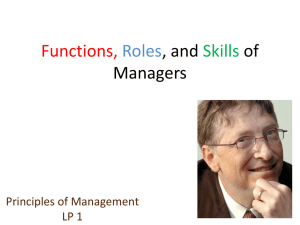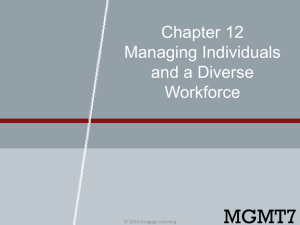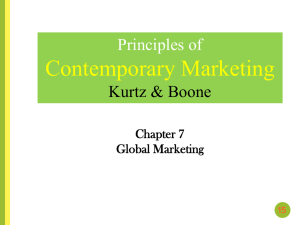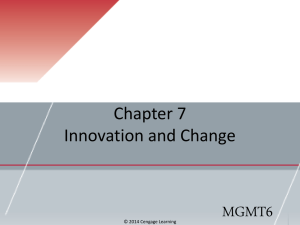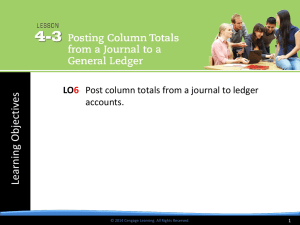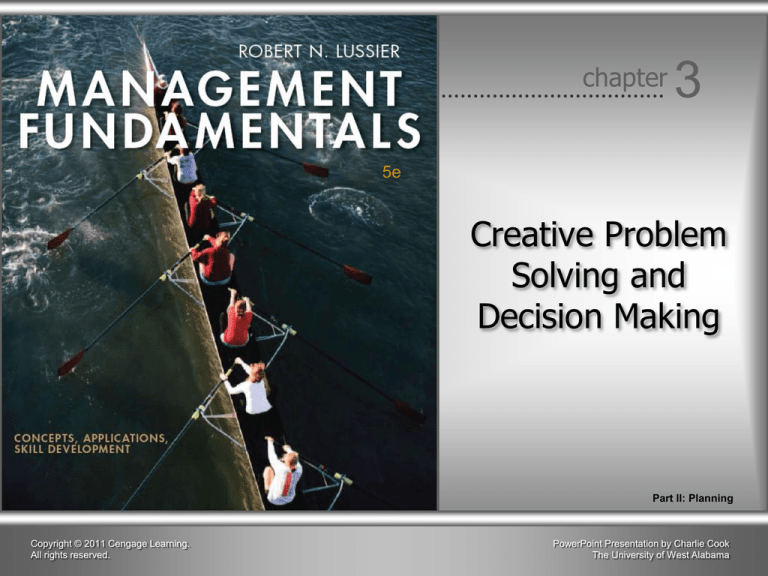
chapter
3
5e
Creative Problem
Solving and
Decision Making
Part II: Planning
Copyright © 2011 Cengage Learning.
All rights reserved.
PowerPoint Presentation by Charlie Cook
The University of West Alabama
Learning Outcomes
After studying this chapter, you should be able to:
1.
2.
3.
4.
5.
6.
Explain the relationship among objectives, problem solving, and
decision making.
Explain the relationship among the management functions,
problem solving, and decision making.
List the six steps in the decision-making model.
Describe the differences between programmed and
nonprogrammed decisions and among the conditions of certainty,
uncertainty, and risk.
Describe when to use the rational decision-making model versus
the bounded rationality model and group versus individual
decision making.
State the difference between an objective and “must” and “want”
criteria.
Copyright © 2011 Cengage Learning. All rights reserved.
3–2
Learning Outcomes (cont’d)
After studying this chapter, you should be able to:
7. State the difference between innovation and creativity.
8. List and explain the three stages in the creative process.
9. Describe the differences among quantitative techniques, the
Kepner-Tregoe method, and cost-benefit analysis for analyzing
and selecting an alternative.
10. Define the key terms listed at the end of the chapter.
Copyright © 2011 Cengage Learning. All rights reserved.
3–3
IDEAS ON MANAGEMENT at Nike
1.
What type of decision did Nike make to sign a large endorsement
contract with young, then-unproven NBA basketball player LeBron
James in 2003?
2.
What objectives does Nike meet through its star athlete
endorsements?
3.
How does Nike demonstrate creativity and innovation?
4.
Does the amount of contracts given to young, unproven athletes pose
a serious financial risk to Nike? Which techniques could Nike use to
analyze the alternatives in contract decisions?
5.
Of what unethical and socially irresponsible labor practices have
critics accused Nike?
6.
What sustainable business practices does Nike use?
7.
Which version of Vroom’s participative decision-making model should
Nike have used to make the decision to sign young, unproven
athletes to contracts?
Copyright © 2011 Cengage Learning. All rights reserved.
3–4
The Relationship among Objectives,
Problem Solving, and Decision Making
• Problem
Exists whenever objectives are not being met.
What is happening vs. what is wanted to happen.
• Problem Solving
The process of taking corrective action to meet
objectives.
• Decision Making
The process of selecting a course of action that will
solve a problem.
First decision: whether or not to take corrective action.
Copyright © 2011 Cengage Learning. All rights reserved.
3–5
Problem Solving and Decision Making
• The Relationship among the Management
Functions, Decision Making, and Problem
Solving
Managers need to make proficient decisions while
performing the functions of management.
Copyright © 2011 Cengage Learning. All rights reserved.
3–6
Decision-Making Styles
• Reflexive Style
Makes quick decisions without taking the time to get
all the information that may be needed and without
considering all the alternatives.
• Reflective Style
Takes plenty of time to make decisions, gathering
considerable information and analyzing several
alternatives.
• Consistent Style
Tends to make decisions without either rushing or
wasting time.
Copyright © 2011 Cengage Learning. All rights reserved.
3–7
Exhibit 3–1
● The Decision-Making Model
Copyright © 2011 Cengage Learning. All rights reserved.
3–8
Copyright © 2011 Cengage Learning. All rights reserved.
3–9
Decision Making in the Global Village
• U.S.-based decision-making styles are different
from the decision-making styles in other cultures
due to differences in:
Time orientation
The use of participative decision making
Orientation toward problem solving rather than
acceptance of the status quo
Copyright © 2011 Cengage Learning. All rights reserved.
3–10
Classify and Define the Problem
• Decision Structure
Programmed Decisions
Arise in recurring or routine situations, for which the decision
maker should use decision rules or organizational policies
and procedures to make the decision.
Nonprogrammed Decisions
Arise in significant and nonrecurring and nonroutine
situations, for which the decision maker should use the
decision-making model.
Copyright © 2011 Cengage Learning. All rights reserved.
3–11
Exhibit 3–2 ● Decision Structure Continuum
Copyright © 2011 Cengage Learning. All rights reserved.
3–12
Decision-Making Conditions
• Certainty
Each alternative’s outcome is known in advance.
• Risk
Probabilities can be assigned to each outcome.
• Uncertainty
Lack of information or knowledge makes the outcome
of each alternative unpredictable such that no
probabilities can be determined.
Copyright © 2011 Cengage Learning. All rights reserved.
3–13
Exhibit 3–3 ● Continuum of Decision-Making Conditions
Copyright © 2011 Cengage Learning. All rights reserved.
3–14
Copyright © 2011 Cengage Learning. All rights reserved.
3–15
Decision-Making Models
• Rational Model (Classical Model)
The decision maker attempts to use optimizing—
selecting the best possible alternative.
• Bounded Rationality Model
The decision maker uses satisficing—selecting the
first alternative that meets the minimal criteria for
solving the problem.
Copyright © 2011 Cengage Learning. All rights reserved.
3–16
Exhibit 3–4 ● Potential Advantages and Disadvantages of Using Group
Decision Making
Copyright © 2011 Cengage Learning. All rights reserved.
3–17
Define the Problem
• Distinguish Symptoms from the Cause of the
Problem
List the observable and describable occurrences
(symptoms) that indicate a problem exists.
Determine the cause of the problem.
Removing the cause should cause the symptoms to
disappear or cease.
Symptom: Customer dissatisfaction
Cause: Poorly trained employees
Solution: Implement customer relations training program for
employees
Copyright © 2011 Cengage Learning. All rights reserved.
3–18
Exhibit 3–5
● Continua for
Classifying a Problem
Copyright © 2011 Cengage Learning. All rights reserved.
3–19
Set Objectives and Criteria
• Setting Objectives
Involves establishing clear objectives that will make
for better decisions.
Objectives state what the decisions should
accomplish in solving a problem or taking advantage
of an opportunity.
• Setting Criteria
Involves setting standards that an alternative must
meet to be selected as the decision that will
accomplish the objective.
Copyright © 2011 Cengage Learning. All rights reserved.
3–20
Join the Discussion
Ethics & Social Responsibility
• Avoiding Taxes
1. Although it is legal, is it ethical for AT&T, Wal-Mart,
and other corporations to take advantage of tax
loopholes to save money?
2. If you became CEO of one of these corporations,
would you continue to take advantage of the tax
loopholes? Why or why not?
3. What is the government’s role and responsibility
regarding tax loopholes?
Copyright © 2011 Cengage Learning. All rights reserved.
3–21
Generate Creative Alternatives
• Innovation
The implementation of a new idea.
Product innovation (new things)
Process innovation (new way of doing things)
• Creativity
A way of thinking that generates new ideas.
• The Creative Process
Preparation
Incubation and illumination
Evaluation
Copyright © 2011 Cengage Learning. All rights reserved.
3–22
Exhibit 3–6 ● Stages in the Creative Process
Copyright © 2011 Cengage Learning. All rights reserved.
3–23
Generating Creative Alternatives
• Brainstorming
The process of suggesting many possible alternatives
without evaluation.
• Synectics
The process of generating novel alternatives through
role playing and fantasizing.
• Nominal Grouping
The process of generating and evaluating alternatives
using a structured voting method that includes listing,
recording, clarification, ranking, discussion, and
voting to select an alternative.
Copyright © 2011 Cengage Learning. All rights reserved.
3–24
Generating Creative Alternatives (cont’d)
• Consensus Mapping (Ringi)
The process of developing group agreement on a
solution to a problem.
• Delphi Technique
The process of using a series of confidential
questionnaires to refine a solution.
Copyright © 2011 Cengage Learning. All rights reserved.
3–25
Exhibit 3–7 ● Group Decision-Making Techniques That Foster Creativity
and Innovation
Copyright © 2011 Cengage Learning. All rights reserved.
3–26
Responses That Kill Creativity
• “It can’t be done.”
• “We’ve never done it.”
• “Has anyone else tried it?”
• “It won’t work in our department
(company/industry).”
• “It costs too much.”
• “It isn’t in the budget.”
• “Let’s form a committee.”
Copyright © 2011 Cengage Learning. All rights reserved.
3–27
Copyright © 2011 Cengage Learning. All rights reserved.
3–28
Exhibit 3–8 ● Decision Tree
Copyright © 2011 Cengage Learning. All rights reserved.
3–29
Analyze Alternatives and Select the Most
Feasible
• Quantitative Techniques
Break-even analysis
Capital budgeting
Payback
Average rate of return
Discounted cash flow
Linear programming
Queuing theory
Probability theory
Copyright © 2011 Cengage Learning. All rights reserved.
3–30
Copyright © 2011 Cengage Learning. All rights reserved.
3–31
The Kepner-Tregoe Method
1. Assess each alternative with regard to the
“must” criteria.
2. Rate the importance of each “want” criterion on
a scale of 1 to 10 (10 is the most important).
3. Determine how well each alternative meets the
“want” criterion.
4. Compute the weighted score (WS) for each
alternative on each criterion.
5. Select the alternative with the highest total
weighted score.
Copyright © 2011 Cengage Learning. All rights reserved.
3–32
Exhibit 3–9 ● The Kepner-Tregoe Method for Analyzing Alternatives
*Indicates importance [on a scale of 10 (high) to 1 (low)] assigned to each criterion as a weight.
Copyright © 2011 Cengage Learning. All rights reserved.
3–33
Cost-Benefit (Pros and Cons) Analysis
• Cost-Benefit Analysis
A technique for comparing the cost and benefit of
each alternative course of action using subjective
intuition and judgment along with math.
• Pros and Cons Analysis
A technique for identifying the advantages, which can
be considered the benefits, and the disadvantages,
which can be considered the costs, of each
alternative.
Copyright © 2011 Cengage Learning. All rights reserved.
3–34
Exhibit 3–10 ● Continuum of Analysis Techniques
Copyright © 2011 Cengage Learning. All rights reserved.
3–35
Join the Discussion
Ethics & Social Responsibility
• Selling Stocks
1. Is it ethical for the company to pay a higher
commission on some stocks?
2. Is it ethical for you to recommend a stock that you
don’t believe is the best stock even though you will
earn a higher commission if you do?
3. What would you do if you didn’t sell the stock and
your boss had a meeting with you to encourage you
to sell the stock?
Copyright © 2011 Cengage Learning. All rights reserved.
3–36
Plan, Implement the Decision, and Control
• Plan
Develop a plan of action and a schedule of
implementation.
• Implement the Plan
Communicate and delegate for direct action.
• Control
Use checkpoints to determine whether the alternative
is solving the problem.
Avoid escalation of commitment to a bad alternative.
Copyright © 2011 Cengage Learning. All rights reserved.
3–37
Vroom’s Participative Decision-Making Model
• Model
Developed by Victor Vroom
A tool that managers can use to answer questions
while improving decision-making effectiveness.
Does not take the place of the decision-making
model; it tells you when to use a group and what level
of participation you should use with the decisionmaking model.
Copyright © 2011 Cengage Learning. All rights reserved.
3–38
Participation Decision Styles
Decide
Consult
Individuals
Facilitate
Copyright © 2011 Cengage Learning. All rights reserved.
Consult
Group
Delegate
3–39
Questions that Determine the Appropriate
Participative Decision Style
Decision
Significance
Leader
Expertise
Importance of
Commitment
Likelihood of
Commitment
Team
Competence
Copyright © 2011 Cengage Learning. All rights reserved.
Diagnostic
Variables
Group Support
for Objectives
Group
Expertise
~–40
Exhibit 3–11 ● Participative Decision-Making Model
Time-Driven
Model
Copyright © 2011 Cengage Learning. All rights reserved.
The model is a decision tree
that works like a funnel. Define
the problem statement; then
move from left to right and
answer each question by
responding either high (H) or
low (L), skipping decisions that
are not appropriate to the
situation and avoiding
crossing any horizontal lines.
The last column indicates the
appropriate leadership
decision-making style for that
situation.
3–41
Exhibit 3–11 ● Participative Decision-Making Model (cont’d)
Development-Driven
Model
Copyright © 2011 Cengage Learning. All rights reserved.
3–42
Time-Driven versus Development-Driven Model
Time-Driven
Development-Driven
Making effective decisions
with minimum cost
Focus
Making effective decisions
through maximum
development of group
members
Emphasizes timely
decision making
Value
Emphasizes group
development
Orientation
Has a long-term horizon,
as group development
takes time
Has a short-term
time horizon
Copyright © 2011 Cengage Learning. All rights reserved.
3–43
Copyright © 2011 Cengage Learning. All rights reserved.
3–44
KEY TERMS
•
•
•
•
•
•
•
brainstorming
consensus mapping
creative process
creativity
criteria
decision making
decision-making
conditions
• decision-making model
• devil’s advocate
approach
Copyright © 2011 Cengage Learning. All rights reserved.
• innovation
• nominal grouping
• nonprogrammed
decisions
• participative decisionmaking model
• problem
• problem solving
• programmed
decisions
• synectics
3–45


